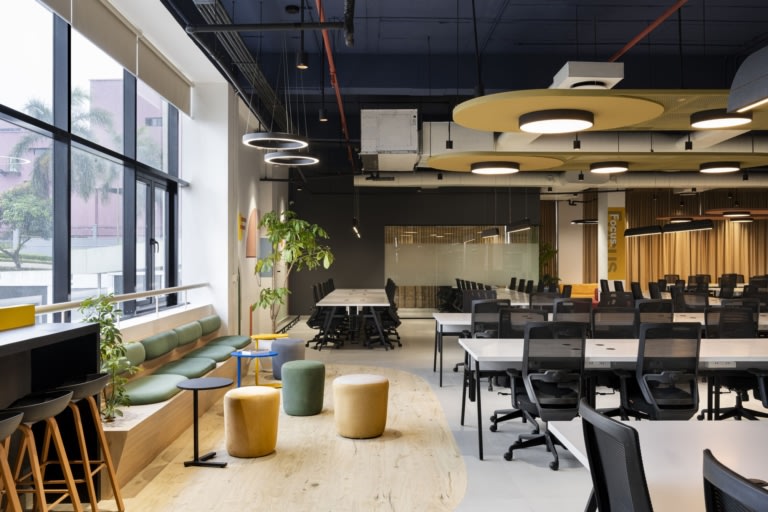In the field of interior design, it is common to come across spaces that feel cramped or limited in size. However, through clever design techniques, it is possible to create an illusion of spaciousness and make even the smallest areas appear larger. By skillfully manipulating colour schemes, furniture placement, lighting, and various other design elements, you can transform any room into a more expansive and open environment. This blog explores effective interior design practices that can make spaces appear bigger, allowing you to maximise the potential of your living areas.
Light & Bright Colour Palette
One fundamental principle for creating an illusion of spaciousness is to use a light and bright colour palette. Lighter hues, such as whites, pastels, and neutrals, reflect more natural light and create an airy atmosphere. Painting walls, ceilings, and furniture in light tones visually opens up the space. Consider utilising monochromatic colour schemes or tones within the same colour family to maintain a cohesive look throughout the room. Mirrors can also be strategically placed to bounce light and create an illusion of increased space.
To create an illusion of space, let’s look at some advice on the use of light and colourful colour palette:
Use of Base Colour
The best reflective colour is white, which allows the space to look bigger and clearer in an instant. Even off-white curtains can work very well, particularly if you want to make a little warmth into the room.
Use Light – Coloured Accents
With the addition of accent walls, pillows, throws and other decorative items you can add a burst of colour and interest to your space without making it feel smaller. Choose light-coloured accents that complement your base colour.
Use Mirros Strategically
Mirrors cast light to create a sense of more space. To disperse light in the room, place mirrors on either side of or at other strategically positioned windows.
The White & Pale Scheme
It’s the perfect choice for creating a soft, airy atmosphere. Choose a white or off-white base colour and pair it with pastel accents in shades of pink, blue, green, and yellow.
The Neutral Scheme
It’s an adaptable and timeless scheme Choose a neutral base colour, such as beige, grey, or taupe, and pair it with other neutral accents in complementary shades.
Monochromatic Design
The monochromatic interior design uses several shades of one colour to create a beautiful, uniform look. Choose a light coloured base colour to be coupled with darker and lighter shades of the same colour.
Smart Furniture Selection
Choosing the right furniture is crucial for optimising space. To make a room appear more spacious, opt for furniture with legs rather than bulky pieces that sit directly on the floor. This allows light to flow underneath, creating a sense of openness. Additionally, consider multifunctional furniture, such as a storage ottoman or a sofa bed, that serves more than one purpose. This way, you can minimise clutter and maximise the functionality of your space.
In order to optimise space and create an illusion of spaciousness, it is important to choose the correct furniture. I’ve got a couple of tips for you:
- Take your pick of furniture with legs. The furniture with legs allow light to flow beneath, giving the room an open feeling and making it feel bigger. Avoid heavy pieces that are placed directly on the floor.
- Choose multifunctional furniture. In order to save space and enhance the room’s comfort. Storage ottomans, for instance, provide additional seat space or storage while a sofa bed is capable of providing further sleeping area to guests.
- Choose furniture that’s the right size in a room. Get rid of furniture that’s too big in the room. Rather, choose the pieces which are adequately sized for a small area and allow sufficient space to be maneuverer easily.
- Use transparent furniture. It can help make a space feel more inviting and airy, for instance by means of translucent furniture like glass or acrylic. In comparison to traditional wooden furniture, such clear glass coffee tables or acrylic dining chairs will take up less visual space.
- With limited space, custom furniture services can be a game-changer. Designing furniture that fits precisely in your space can maximise functionality and minimise clutter. Consider pieces with built-in storage to keep your belongings organised and out of sight.
Furniture Placement
Strategic furniture placement plays a significant role in enhancing the perceived size of a room. Avoid blocking pathways and place furniture away from entryways to create an unobstructed flow. Leave some breathing space between furniture pieces to create a sense of openness. In smaller rooms, floating furniture away from walls can help create the illusion of depth and make the room feel larger. By arranging furniture in a way that encourages movement and provides a clear line of sight, you can maximise the perception of space.
The size of a room may be significantly influenced by the optimal placement of furniture. We’ve got a few tips for you:
Flooring Options
The choice of flooring options selection service can significantly impact how spacious a room appears. Light-coloured flooring, such as light wood or pale-coloured tiles, can reflect more light and create a sense of openness. Consider a consistent flooring material throughout your home to avoid visual interruptions.
Avoid blocking pathways
Leave plenty of space in the room for people to go about their business without interference. It can make a room feel crowded and empty when furniture is placed so near each other. You do not allow furniture to be placed in such a way as to obstruct the room’s view. The room will be more open and airy as a result.
Get furniture away from the entrances
This is going to open up the room, so that it feels more spacious. Consider using a desk or thin shelf instead of an imposing piece of furniture if you’ve got small foyers
Sit furniture out of sight of the walls
This may give rise to the illusion of depth, making this room feel bigger. For example, you’re free to move a couch out of the wall and make your coffee table right next to it.
Promotes movement
This will allow the room to feel more dynamic and less static. For example, in order to create an area for talking, it would be possible to place the armchair and chairs opposite each other.
Utilise Vertical Space
Make the most of your vertical space to draw the eyes upward and create an illusion of height. Install floor-to-ceiling curtains to create the illusion of taller windows. Use tall bookshelves or wall-mounted shelves to display items and draw attention upward. Vertical stripes, whether in wallpaper or accent pieces, can also create the perception of higher ceilings. By emphasising the vertical dimension, you can make a room feel more expansive.
To make the illusion of height, I am going to give you a few suggestions for using horizontal space:
- Install floor-to-ceiling curtains : It will create an illusion of taller windows, thereby increasing the size of the room. Display items and attract attention to them on tall bookshelves or walled shelves.
- In order to create the perception of higher ceilings, horizontal stripes should be used, whether they are on wallpaper or accent pieces.
- From the ceiling, hang hanging plants or mobiles: It’ll help to get your eyes up so that the room will feel bigger.
- Mirrors are used to reflect the light, creating an illusion of more space.
- To create a larger and brighter space, position mirrors strategically around the room so that they move light in different directions.
Adequate Lighting
Proper lighting can greatly impact the perceived size of a space. Maximise natural light by keeping windows unobstructed or using sheer curtains. For artificial lighting, opt for multiple light sources to eliminate shadows and create an evenly lit environment. Recessed lighting and track lighting are great options as they provide illumination without taking up much visual space. Additionally, incorporating reflective surfaces, such as glossy finishes or metallic accents, can help bounce light around the room and make it feel larger.
Maximising Natural Light
You can increase natural light by keeping windows clear and using sheer curtains, as well:
- In light colours, paint your walls and ceilings: Light colours reflect more light, making the room feel brighter and more spacious.
- Placing mirrors on the other side of the windows: Mirror reflects light, so it could be twice as much natural light in the room.
- Using a skylight or tubes of light: A great way to bring the natural light into dark, windowless places is through Skylights and Light Tubes.
- Utilise window treatments interior design services. Choose curtains or blinds that extend beyond the window frame to give the impression of more oversized windows. Light, sheer fabrics can allow more natural light to filter in, making the room feel airier and more spacious.
Using Artificial Lighting Strategically
You can also use artificial lighting on a strategic level by using more than one source of light, in the form of Recessed or Track Lights as :
- Using dimmers: These dimmers are capable of adjusting the brightness of your lights, which may be helpful to creating a more pleasant and comfortable atmosphere.
- Using accent lighting: In order to emphasize particular features of a room, such as paintings, plants or architecture, accent lighting may be applied.
- Using task lighting: The task lights provide special illumination for some of the activities, e.g. reading, working or cooking.
Incorporating Reflective Surfaces
You can also include reflective surfaces to your space by applying the following solutions, besides gloss finishes and metal accents:
- Mirrored furniture: In order to make the room feel bigger, mirrors can be helpful in reflecting light.
- Glass tables and shelves may also be able to reflect the light, thereby creating an atmosphere of openness and flexibility in the room.
Examples on how to create a larger space by lighting in a variety of rooms within the house, you can see how to use lighting for making your space look bigger:
- Living room: In order to create a sense of high ceilings, place uplights in the corners of the room. A fireplace or a piece of art may also be illuminated with backlight.
- Kitchen: To create a general illumination, light the kitchen with recessed lighting. To improve the focus of your work space, you can set up task lighting on the stove and sink.
- Bedrooms: use back lighting behind the headboards or beds. To read or get ready for bed, you can also use task lights on either side of the bed.
When it comes to creating a sense of spaciousness in your home, the choice of flooring is key. Opting for light-colored flooring, such as light wood or pale-colored tiles, can significantly impact how large a room appears. This choice reflects more light, contributing to the illusion of openness. To maintain a seamless and unbroken visual flow, consider using a consistent flooring material throughout your home. By doing so, you can enhance the overall perception of spaciousness in your living environment with Oraanj Interior Design.
Author- Gunjan Khemka & Rutuja Borade (Interior Designer)






